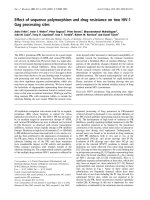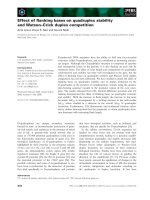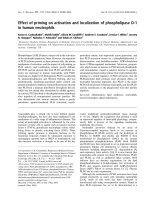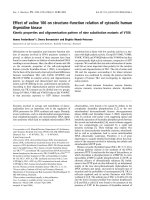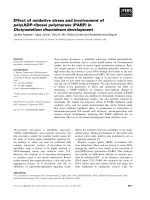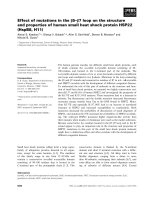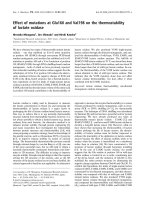Báo cáo khoa học: "Effect of inoculation and substrate disinfection method on rooting and ectomycorrhiza formation of Douglas fir cutting" ppt
Bạn đang xem bản rút gọn của tài liệu. Xem và tải ngay bản đầy đủ của tài liệu tại đây (465.46 KB, 6 trang )
Original
article
Effect
of
inoculation
and
substrate
disinfection
method
on
rooting
and
ectomycorrhiza
formation
of
Douglas
fir
cuttings
Javier
Parladé
Joan
Pera
Isabel
F.
Álvarez
a
Daniel
Bouchard
b
Benoit
Généré
c
François
Le
Tacon
b
a
Departament
de
Patologia
Vegetal,
Ctra
de
Cabrils
s/n,
IRTA,
08348
Cabrils,
Barcelona,
Spain
b
Centre
de
recherches
forestièrès
de
Nancy,
Inra,
54280
Champenoux,
France
c
Cemagref,
Domaine
des
Barres,
45290
Nogent-sur-Vernisson,
France
(Received
2
February
1998;
accepted 11
May
1998)
Abstract -
Ectomycorrhizal
inoculation
techniques
were
applied
to
Douglas
fir
(Pseudotsuga
menziesii
(Mirb)
Franco)
cuttings,
dur-
ing
the
rooting
phase,
to
determine
the
effect
of
inoculation
on
rooting
and
mycorrhizal
colonization.
Two
experiments
were
con-
ducted:
1)
an
inoculation
experiment,
established
at
three
different
locations
with
the
same
treatments,
to
determine
the
effect
of
inoc-
ulation
with
Laccaria
bicolor,
Melanogaster
ambiguus
and
Rhizopogon
subareolatus;
and
2)
a
local
factorial
experiment
to
determine
the
effect
of fungal
inoculation,
substrate
disinfection
methods,
and
their
possible
interactions.
At
Peyrat-le-Château
and
Champenoux
(France),
there
were
no
differences
in
rooting
due
to
the
inoculation
treatment.
At
Cabrils
(Spain),
the
cuttings
inoculated
with
L.
bicol-
or
and
R.
subareolatus
rooted
significantly
better
than
non-inoculated
cuttings.
Vegetative
inoculum
of
L.
bicolor
and
spores
of
R.
subareolatus
were
effective
in
forming
ectomycorrhizas
in
the
three
locations,
whereas
spores
of
M.
ambiguus
were
effective
only
at
Cabrils.
Substrate
disinfection
with
methyl
bromide
significantly
decreased
the
percentage
of rooted
cuttings
compared
to
steam-dis-
infected
substrate.
Methyl
bromide
application
also
lowered
the
percentage
of
mycorrhizal
cuttings
after
inoculation
with
L.
bicolor
and
R. subareolatus.
The
disinfection
method
did
not
alter
significantly
the
colonization
level
among
the
mycorrhizal
plants.
(@
Inra/Elsevier,
Paris.)
Laccaria
bicolor
/
Melanogaster
ambiguus
/
Rhizopogon
subareolatus
/
propagation
/
mycorrhiza
Résumé -
Effet
de
méthodes
d’inoculation
et
de
désinfection
du
substrat
sur
l’enracinement
de
boutures
de
douglas
et
sur
la
formation
de
mycorhizes.
La
mycorhization
contrôlée
de
boutures
de
douglas
(Pseudotsuga
menziesii
(Mirb)
Franco)
a
été
étudiée
durant
la
phase
d’enracinement,
afin
de
mesurer
son
effet
sur
l’enracinement
et
sur
l’état
mycorhizien
final
des
plants.
Deux
essais
ont
été
suivis:
1)
un
essai
commun
à
trois
sites
comparant
l’effet
de
souches
fongiques
de
Laccaria
bicolor,
Melauogaster
ambiguus
et
Rhizopogon
subareolatus,
et
2)
un
essai
factoriel
local
testant
l’effet
de
l’inoculation,
du
mode
de
désinfection
du
substrat
et
leurs
interactions.
Contrairement
à
Peyrat-le-Château
et
à
Champenoux
où
le
taux
d’enracinement
n’a
pas
été
modifié
par
les
symbiotes
inoculés,
les
boutures
inoculées
par
L.
bicolor
and
R. subareolatus
se
sont
mieux
enracinées
que
les
témoins
à
Cabrils.
Le
mycélium
de
L.
bicolor
et
les
spores
de
R. subareolatus
ont
permis
la
formation
de
mycorhizes
sur
les
trois
sites,
alors
que
les
spores
de
M.
ambiguus
ne
l’ont
permis
qu’à
Cabrils.
La
désinfection
du
substrat
au
bromure
de
méthyle
a
réduit
significativement
le
taux
de
boutures
racinées
par
rapport
à
celle
effectuée
à
la
vapeur.
L’application
de
bromure
de
méthyle
a
diminué
également
le
taux
de
bou-
tures
mycorhizées,
après
inoculation
par
L.
bicolor
et
R. subareolatus.
En
revanche,
la
méthode
de
désinfection
n’a
pas
modifié
signi-
ficativement
le
taux
de
mycorhization
des
plants
effectivement
mycorhizés.
(©
Inra/Elsevier,
Paris.)
Laccaria
bicolor
/
Melanogaster
ambiguus
/
Rhizopogon
subareolatus
/
multiplication
végétative
/
mycorhize
*
Correspondence
and
reprints
1.
INTRODUCTION
Vegetative
propagation
of
forest
trees
is
an
alternative
to
the
lack
of
seeds
of
high
genetic
value
when
a
breed-
ing
programme
has
been
concluded.
Several
species
of
forest
trees
can
be
propagated
as
rooted
cuttings
from
selected
mother
plants
[22].
The
increasing
availability
of
genetically
improved
Douglas
fir
(Pseudotsuga
menziesii
(Mirb)
Franco)
seed,
its
successful
propagation
from
cut-
tings
in
North
America
[23],
and
its
increasing
impor-
tance
as
a
reforestation
species
in
Europe
[17]
make
this
species
a
good
candidate
to
be
propagated
as
rooted
cut-
tings.
Since
this
propagation
method
is
more
expensive
than
seedling
production,
the
effort
to
improve
the
root-
ing
process
and
the
performance
of
the
rooted
cuttings
in
the
nursery
and
after
field
transplantation
is
of
great
inter-
est.
The
critical
stages
during
cutting
propagation
are
the
rooting
phase
and
the
transplantation
to
nursery
beds
and
to
the
field.
Inoculation
of
Douglas
fir
seedlings
with
selected
ectomycorrhizal
fungi,
in
both
containerized
and
bareroot
nurseries,
can
increase
survival
and/or
growth
of
the
plants
in
the
nursery
phase
[13]
and
when
outplanted
in
the
field
in
European
trials
[1,
2,
9,
15,
27].
On
cut-
tings,
the
fungal
inoculum
is
generally
supplied
when
the
rooted
cuttings
are
transplanted
in
fumigated
beds
[10].
In
this
study,
we
inoculated
directly
during
the
rooting
phase
to
determine
the
effect
of
inoculation
on
rooting
and
mycorrhizal
colonization.
Available
inoculation
tech-
niques
with
ectomycorrhizal
fungi
used
for
containerized
seedlings
were
applied
and
adapted
to
Douglas
fir
cut-
tings.
Two
experiments
were
designed:
1)
an
inoculation
experiment,
established
at
three
different
locations
with
the
same
treatments,
to
determine
the
effect
of
inocula-
tion
with
Laccaria
bicolor,
Melanogaster
ambiguus
and
Rhizopogon
subareolatus;
and
2)
a
local
factorial
experi-
ment
to
determine
the
effects
of
inoculation
with
the
above
fungi
and
the substrate
disinfection
method.
2.
MATERIALS
AND
METHODS
2.1.
Inoculation
experiments
at
three
different
locations
The
experiments
were
set
up
in
greenhouses
at
three
experimental
locations:
the
nursery
of
Peyrat-le-Château
located
in
central
France,
and
the
research
centres
of
Champenoux
in
northeast
France
and
Cabrils
in
northeast
Spain.
Douglas
fir
cuttings
were
obtained
from
a
total
of
200
3-year-old
mother
plants
(seed
orchard
24
established
at
Bout,
Allier,
France)
in
February
1995.
The
cuttings
were
mixed
homogeneously
and
cold
stored
at
2
°C
for
4
weeks
to
improve
rooting.
After
storage,
the
bases
of
the
cuttings
were
dipped
in
a
solution
of
Exuberone®
(Rhone
Poulenc,
4
g
L
-1
indole-butyric
acid,
IBA)
for
24
h.
The
substrate,
consisting
of
a
mixture
of
peat
and
vermiculite
(1:1, v:v),
was
disinfected
with
60
g
L
-1
methyl
bromide
(2
%
chloropicrine)
at
a
temperature
over
13
°C.
The
con-
tainers
were
plastic
horticultural
trays
(510
x
365
x
180
mm)
at
Peyrat-le
Château,
HIKO®
plates
with
40
alveoles
of
90
cc
each
at
Champenoux,
and
forest-pot
containers,
150
cc
each,
at
Cabrils.
Insertion
of
the
cuttings
was
done
during
the
first
week
of
March
1995,
2
weeks
after
sub-
strate
disinfection.
Laccaria
bicolor
(R
Mre)
Orton
strain
S-238
N
was
inoculated
at
insertion
as
vegetative
inoculum
grown
in
peat:vermiculite
as
described
by
Marx
and
Bryan
[16]
at
the
rate
of
1:20
(v:v,
inoculum:substrate).
Sporocarps
of
Melanogaster
ambiguus
(Vitt)
Tul
&
Tul
and
Rhizopogon
subareolatus
Smith
were
collected
in
the
Montseny
range,
Girona,
northeast
Spain,
in
autumn
1994.
Spore
inoculum
of
both
fungi
was
prepared
as
described
by
Castellano
et
al.
[6]
and
applied
2
months
after
insertion
at
the
rate
of
10
6
spores
per
cutting
as
described
in
Parladé et al.
[21].
For
each
location,
the
experimental
design
consisted
of
four
replications
of
40
cuttings
(experimental
unit)
for
each
inoculation
treatment
including
a
control,
non-inoc-
ulated
treatment.
The
trays
were
distributed
randomly
in
a
greenhouse
and
maintained
under
mist
irrigation
during
the
rooting
process
and
afterwards,
under
regular
irriga-
tion.
Fertirrigation
was
started
4
months
after
insertion
by
using
the
N-P-K
soluble
fertilizer
Plant
Prod
20-20-20
sprayed
weekly
at
the
rate
of
1.5
g
m
-2
.
2.2.
Factorial
experiment
at
Cabrils
location
The
factorial
experiment
design
included
two
factors:
inoculation
and
the
substrate
disinfection
method
with
four
replications
of
40
cuttings
(experimental
unit)
for
each
treatment.
Fungal
inocula,
inoculation
levels
and
growing
conditions
were
exactly
the
same
as
described
earlier.
The
disinfection
levels
were
methyl
bromide
applied
as
in
the
previous
experiment,
and
steam
was
applied
twice
at
90
°C
for
I
h with
a
24-h
period
between
applications.
Eight
months
after
insertion,
all
the
cuttings
from
both
experiments
were
assessed
visually
for
rooting
(root
sys-
tem
fully
developed)
and
mycorrhizal
colonization.
Forty
cuttings
taken
randomly
from
each
treatment
were
exam-
ined
for
root
colonization
by
counting
at
least
200
short
roots
per
plant
under
a
stereomicroscope.
Only
mycor-
rhizal
plants
were
considered
to
determine
the
coloniza-
tion
level.
Rooting
and
mycorrhizal
colonization
data
were
analyzed
by
analysis
of
variance
(ANOVA)
on
the
mean
values
per
experimental
unit
(tray
of
40
plants).
Colonization
percentages
were
transformed
with
the
arc
sinus
function
to
reduce
the
error
variance
[26]
before
performing
the
ANOVA.
Differences
among
means
were
detected
by
Tukey’s
test
(P ≤
0.05).
3. RESULTS
3.1.
Inoculation
experiments
at
three
different
locations
At
Peyrat-le-Château
and
Champenoux,
there
were
no
differences
in
rooting
due
to
the
inoculation
treatment.
At
Cabrils,
the
cuttings
inoculated
with
L.
bicolor
and
R.
subareolatus
rooted
significantly
better
than
non-inocu-
lated
cuttings.
The
average
rooting
percentage,
however,
was
lower
than
in
the
other
two
locations
(table
I).
The
cuttings
inoculated
with
L.
bicolor
became
myc-
orrhizal
in
a
proportion
varying
from
20
to
89
%,
depend-
ing
on
the
location
(table
II).
The
mycorrhizal
short
roots
rate
(colonization
level)
among
the
mycorrhizal
plants
ranged
from
40
to
59 %
(table
III).
The
proportion
of
mycorrhizal
cuttings
with
R. subareolatus
varied
from
31
to
88 %
among
locations
(table
II).
The
colonization
level
ranged
from
14
to
39 %
of
the
short
roots
(table
III).
The
inoculation
with
M.
ambiguus
was
effective
only
at
Cabrils.
Only
8 %
of
the
plants
became
mycorrhizal
(table
II)
with
an
average
of
31
%
of
the
short
roots
col-
onized
(table
III).
3.2.
Factorial
experiment
at
Cabrils
The
percentage
of
rooted
cuttings
was
significantly
affected
by
both
inoculation
(P
=
0.0006)
and
disinfection
(P
=
0.0000)
factors.
No
significant
interactions
were
detected
between
them
(P
=
0.7223).
Inoculation
with
L.
bicolor
and
R.
subareolatus
significantly
increased
the
percentage
of
rooted
cuttings
over
non-inoculated
cut-
tings
(table
IV).
No
significant
effect
on
rooting
occurred
when
the
cuttings
were
inoculated
with
M.
ambiguus.
Substrate
disinfection
with
methyl
bromide
signifi-
cantly
decreased
the
percentage
of
rooted
cuttings
com-
pared
to
the
rooting
percentage
obtained
on
steam-disin-
fected
substrate
(43
and
70
%,
respectively).
Methyl
bro-
mide
application
also
decreased
the
percentage
of
mycor-
rhizal
cuttings
after
inoculation
with
L.
bicolor
and
R.
subareolatus
(table
V).
The
disinfection
method
did
not
significantly
affect
the
colonization
level
of
the
plants
for
any
of
the
inoculation
treatments
(table
V).
4.
DISCUSSION
The
substrate
disinfection
with
methyl
bromide
per-
formed
at
Cabrils
decreased
the
average
rooting
potential
probably
because
of
the
persistence
of
phytotoxic
residu-
als
in
the
substrate.
Although
methyl
bromide
is
consid-
ered
a
short-residual
sterilant
when
applied
properly
in
the
soil
[4],
it
may
persist
in
organic
or
clayey
soils
pro-
ducing
phytotoxic
effects
[24].
Methyl
bromide
has
been
widely
used
in
bareroot
nurseries
in
mycorrhizal
inocula-
tion
programmes
to
reduce
competition
between
wild
and
inoculated
fungi,
as
well
as
to
control
soil-borne
root
pathogens
[7].
However,
steam
has
been
recommended
for
the
disinfection
of
artificial
growing
media
in
con-
tainer
nurseries
[5].
Chemicals
such
as
chloropicrin,
methyl
bromide
and
Vapam®
are
also
used
for
steriliza-
tion
of
growing
media,
but
they
may
bind
with
the
expanded
vermiculite
causing
phytotoxicity
even
after
prolonged
aeration
[28].
Problems
caused
by
methyl
bro-
mide
as
a
disinfectant
were
not
consistent
among
loca-
tions
although
the
application
methodology
was
the
same.
As
Molina
and
Trappe
stated
[19],
a
given
chemical
will
not
necessarily
produce
the
same
response
in
all
species
of
fungi
or
hosts
or
in
all
nurseries.
In
any
case,
the
use
of
steam
can
avoid
the
possible
phytotoxicity
problems
of
residuals
connected
with
local
growth
conditions
(sub-
strate
compaction,
container
type,
temperature,
humidity,
etc.).
In
addition,
methyl
bromide
has
been
listed
under
the
Montreal
Protocol
on
Substances
that
Deplete
the
Ozone
Layer
and
is
to
be
banned
in
the
future.
The
use
of
steam
as
soil
disinfectant
has
been
cited
in
some
case
studies
[3]
as
a
relatively
inexpensive
and
efficient
alter-
native
to
methyl
bromide.
Inoculation
with
L.
bicolor
and
R.
subareolatus
only
increased
significantly
the
rooting
performance
of
the
cuttings
produced
at
Cabrils.
At
the
other
two
locations,
the
average
rooting
percentages
were
higher
than those
in
Cabrils
and
no
inoculation
effect
was
detected.
The
mechanism
underlying
the
fungal
ability
to
improve
the
rooting
performance
is
unclear.
It
has
been
demonstrated
that
several
fungi
produce
indole-acetic
acid,
(IAA)
in
variable
amounts,
which
play
a role
in
the
stimulation
of
root
branching
during
the
mycorrhizal
colonization
[8,
25].
Inoculation
with
vegetative
inoculum
of
L.
bicolor
at
insertion
was
successful
at
the three
locations.
The
vari-
ability
observed
in
the
colonization
data
is
consistent
with
the
results
obtained
with
Douglas
fir
seedlings
in
previ-
ous
inoculation
experiments
with
the
same
fungal
species
[11,
12,
14,
18, 20].
Inoculations
with
spores
of
M.
ambiguus
and
R. sub-
areolatus
made
at
Cabrils
resulted
in
root
colonization
percentages
similar
to
those
obtained
with
seedlings
in
previous
experiments
[21
]. At
the
other
two
locations,
only
spore
inoculations
with
R. subareolatus
were
effec-
tive.
Since
fungal
inoculum,
plant
material
and
substrate
were
the
same
in
the three
locations,
the
failure
of
M.
ambiguus
in
France
could be
due
to
the
different
envi-
ronmental
growth
conditions
(temperature,
humidity,
light)
between
France
and
Spain.
The
methyl
bromide
disinfection
method
applied
at
Cabrils
also
lowered
the
percentage
of
mycorrhizal
plants
obtained
after
inoculation
with
L.
bicolor
and
R. subare-
olatus.
The
presence
of
toxic
residuals
in
the substrate
could
alter
the
fungal
development
after
their
inoculation.
The
lack
of
effect
on
M.
ambiguus
may
be
due
to
the
delay
in
its
development
compared
with
that
of
the
other
two
fungi.
In
this,
and
other
experiments
carried
out
with
seedlings,
it
has
been
observed
that
this
fungus
takes
much
longer
than
L.
bicolor
and
R. subareolatus
to
form
ectomycorrhizas
[21].
It
can
be
hypothesized
that
spore
germination
takes
place
when
the
toxic
effect
remaining
in
the substrate
has
disappeared.
For
the
three
fungi,
the
mycorrhizal
short
root
rate
among
the
mycorrhizal
plants
was
not
affected
by
the
disinfection
method,
indicating
that
the toxic
effect
on
the
fungi
was
produced
before
the
fungal
penetration
into
the
root.
From
these
experimental
results,
it
is
possible
to
use
the available
inoculation
techniques
during
the
rooting
phase
to
obtain
mycorrhizal
Douglas
fir
cuttings.
Inoculation
with
certain
ectomycorrhizal
fungi
improved
rooting
performance
only
at
Cabrils
where
the
rooting
percentage
of
non-inoculated
cuttings
was
clearly
under
that
obtained
at
the
other
two
locations.
In
any
case,
sub-
strate
treatment
with
steam
seems
to
be
the
best
disinfec-
tion
method
to
optimize
both
rooting
performance
and
short
root
mycorrhizal
colonization.
Further
research
is
needed
to
test
the
field
performance
of
the
mycorrhizal
rooted
cuttings
and
to
compare
the
results
with
those
obtained with
seedlings.
Acknowledgements:
Financial
support
for
this
research
was
provided
by
the
European
Union
contract
AIR
3
CT
93-1742.
The
authors
also
wish
to
thank
A.
Rodriguez,
G.
Vega
and
A.
Thivolle-Cazat
for
their
tech-
nical
support
on
rooting
techniques.
REFERENCES
[1]
Alvarez
I.F.,
Duñabeitia
M.,
Espinel
S.,
Hormilla
S.,
Parladé
J.,
Peña
J.I.,
Pera
J.,
Field
performance
of
containerized
Douglas
fir
seedlings
inoculated
with
three
hypogeous
fungi,
in:
Azcon-Aguilar
C.,
Barea
J.M.
(Eds.),
Mycorrhizas
in
Integrated
Systems
from
Genes
to
Plant
Development,
European
Commission
Report
EUR
16728
EN,
Brussels,
Luxembourg,
1994,
pp.
413-416.
[2]
Alvarez
I.F.,
Parladé
J.,
Pera
J.,
Espinel
S.,
Bouchard
D.,
Le
Tacon
F.,
Performance
of
bareroot
Douglas
fir
seedlings
inoculated
with
Lacoaria
bicolor
S-238
five
years
after
field
outplanting,
in:
Azcon-Aguilar
C.,
Barea
J.M.
(Eds.),
Mycorrhizas
in
Integrated
Systems
from
Genes
to
Plant
Development,
European
Commission
Report
EUR
16728
EN,
Brussels,
Luxembourg,
1994,
pp.
417-419.
[3]
Banks
H.J.,
Agricultural
Production
without
Methyl
Bromide -
Four
Case
Studies,
CSIRO
Division
of Entomology,
CSIRO
Australia,
1995.
[4]
Bohmont
B.L.,
The
New
Pesticide
User’s
Guide,
Reston
Publishing
Company
Inc.,
Reston,
VA,
1983.
[5]
Castellano
M.A.,
Molina
R.,
Mycorrhizae,
in:
Landis
T.D.,
Tinus
R.W.,
McDonald
S.E.,
Barnett
J.P.
(Eds.),
The
Container
Tree
Nursery
Manual
Agric.
Handbook
674,
Washington
DC,
US
Department
of
Agriculture,
Forest
Service,
1989, pp. 101-167.
[6]
Castellano
M.A.,
Trappe
J.M.,
Molina
R.,
Inoculation
of
container-grown
Douglas
fir
with
basidiospores
of
Rhizopogon
vinicolor
and
R.
colossus:
effects
of
fertility
and
spore
applica-
tion
rate,
Can.
J.
For.
Res.
15
(1985)
10-13.
[7]
Cordell
C.E.,
Marx
D.H.,
Effects
of
nursery
cultural
practices
on
management
of
specific
ectomycorrhizae
on
bare-
root
tree
seedlings,
in:
Pfleger
F.L.,
Linderman
R.G.
(Eds.),
Mycorrhizae
and
Plant
Health,
APS
Press,
St.
Paul,
MN,
1994,
pp. 133-151.
[8]
Gay
G.,
Gea
L.,
Rôle
de
l’auxine
fongique
dans
la
for-
mation
des
ectomycorhizes,
Acta
Bot.
Gallica
141
(1994)
491-496.
[9]
Généré
B.,
Évaluation
en jeune
plantation
de
deux
types
de
plants
de
douglas
mycorhizés
artificiellement
par
Laccaria
laccata
S
238
N,
Ann.
Sci.
For.
52
(1995)
375-384.
[10]
Généré
B.,
Le
Tacon
F.,
Amirault
J.M.,
Bouchard
D.,
La
mycorhization
contrôlée
de
boutures
d’épicéa
commun
en
pépinière,
Rev.
For.
Fr.
46
(1994)
49-58.
[11
] Hung
L.L.,
Molina
R.,
Use
of
the
ectomycorrhizal
fun-
gus
Laccaria
laccata
in
forestry.
III.
Effects
of
commercially
produced
inoculum
on
container-grown
Douglas
fir
and
pon-
derosa
pine
seedlings,
Can.
J.
For.
Res.
16
(1986)
802-806.
[12]
Hung
L.L.,
Trappe
J.M.,
Ectomycorrhizal
inoculation
of
Douglas
fir
transplanted
container
seedlings
with
commer-
cially
produced
inoculum,
New
Forests
1 (1987)
141-152.
[13]
Le Tacon
F.,
Bouchard
D.,
Effects
of
different
ectomy-
corrhizal
fungi
on
growth
of
larch,
Douglas
fir,
Scots
pine
and
Norway
spruce
seedlings
in
fumigated
nursery
soil,
Acta
Oecol.
Oecol.
Appl.
7
(4)
(1986)
389-402.
[14]
Le
Tacon
F.,
Garbaye
J.,
Bouchard
D.,
Chevalier
G.,
Olivier
J.M.,
Guimberteau
J.,
Poitou
N.,
Frochot
N.,
Field
results
from
ectomycorrhizal
inoculation
in
France,
in:
Lalonde
M.,
Piché
Y.
(Eds.),
Proceedings
of
the
Canadian
Workshop
on
Mycorrhizae
in
Forestry,
1-4
May
1988,
Centre
de
recherche
en
biologie
forestière,
Faculté
de
foresterie
et
de
géodésie,
Université
Laval,
Sainte-Foy,
Québec,
1988.
[15]
Le
Tacon
F.,
Alvarez
I.F.,
Bouchard
D.,
Henrion
B.,
Jackson
R.M.,
Luff
S.,
Parladé
J.,
Pera
J.,
Stenström
E.,
Villeneuve
N.,
Walker
C.,
Variations
in
field
response
of
forest
trees
to
nursery
ectomycorrhizal
inoculation
in
Europe,
in:
Read
D.J.,
Lewis
D.H.,
Fitter
A.H.,
Alexander
I.J.
(Eds.),
Mycorrhizas
in
Ecosystems,
CAB,
Wallingford,
1992,
pp.
119-134.
[16]
Marx
D.H.,
Bryan
W.C.,
Growth
and
ectomycorrhizal
development
of
loblolly
pine
seedlings
in
fumigated
soil
infest-
ed
with
the
fungal
symbiont
Pisolithus
tinctorius,
For.
Sci.
21
(1975)
245-254.
[17]
Matthews
J.D.,
The
Role
of
North-West
American
Trees
in
Western
Europe,
H.R.
McMillan
Lectureship
in
Forestry,
Univ.
BC,
Vancouver,
BC,
1983.
[18]
Molina
R.,
Use
of
the
ectomycorrhizal
fungus
Laccaria
laccata
in
forestry.
I.
Consistency
between
isolates
in
effective
colonization
of
containerized
conifer
seedlings,
Can.
J.
For.
Res.
12
(1982)
469-473.
[19]
Molina
R.,
Trappe
J.M.,
Mycorrhiza
management
in
bareroot
nurseries,
in:
Duryea
M.L.,
Landis
T.D.
(Eds.),
Forestry
Nursery
Manual:
Production
of
Bareroot
Seedlings,
Martinus
Nijhoff/Dr
W.
Junk
Publishers,
the
Hague,
1984,
pp.
211-223.
[20]
Parladé
J.,
Técnicas
de
inoculación
de
abeto
de
Douglas
[Pseudotsuga
menziesii
(Mirb.)
Franco]
con
hongos
ectomicorrícicos
y
su
aplicación
en
reforestación,
tesis
doctoral,
Universidad
Autónoma
de
Barcelona,
Spain,
1992.
[21]
Parladé
J.,
Pera
J.,
Alvarez
I.F.,
Inoculation
of
con-
tainerized
Pseudotsuga
menziesii
and
Pinus
pinaster
seedlings
with
spores
of
five
species
of
ectomycorrhizal
fungi,
Mycorrhiza
6
(1996)
237-245.
[22]
Ritchie
G.A.,
The
commercial
use
of
conifer
rooted
cuttings
in
forestry:
a
world
overview,
New
Forests
5
( 1992)
247-275.
[23]
Ritchie
G.A.,
Tanaka
Y.,
Meade
R.,
Duke
S.D.,
Field
survival
and
early
growth
of
Douglas
fir
rooted
cuttings:
rela-
tionship
to
stem
diameter
and
root
system
quality,
For.
Ecol.
Manage.
60
(1993)
237-256.
[24]
Shurtleff
M.C.,
How
to
Control
Plant
Diseases,
Iowa
State
University
Press,
Ames,
IA,
1966.
[25]
Slankis
V.,
Hormonal
relationship
in
mycorrhiza,
in:
Marks
G.C.,
Kozlowski
T.T.
(Eds.),
Ectomycorrhizae -
Their
Ecology
and
Physiology,
Academic
Press,
New
York,
London,
1973, pp. 231-298.
[26]
Snedecor
G.W.,
Cochran
W.G.,
Statistical
Methods,
Iowa
State
University
Press,
Ames,
IA,
1980.
[27]
Stenström
E.,
Ek
M.,
Field
growth
of
Pinus
sylvestris
following
nursery
inoculation
with
mycorrhizal
fungi,
Can.
J.
For.
Res.
20
(1990)
914-918.
[28]
Tinus
R.W.,
McDonald
S.E.,
How
to
Grow
Tree
Seedlings
in
Containers
in
Greenhouses,
USDA
Fr.
Serv.
Gen.
Tech.
Rep.
RM-60,
Rocky
Mt.
For.
and
Range
Exp.
Stn.,
For.
Serv.,
US
Dept.
Agric.,
Fort
Collins,
CO
80526,
1979.



